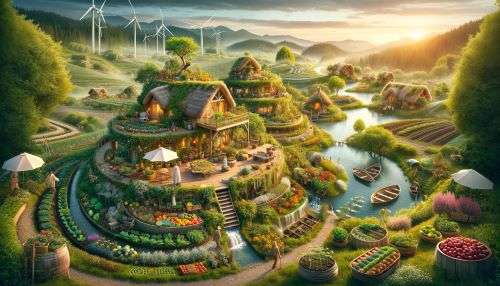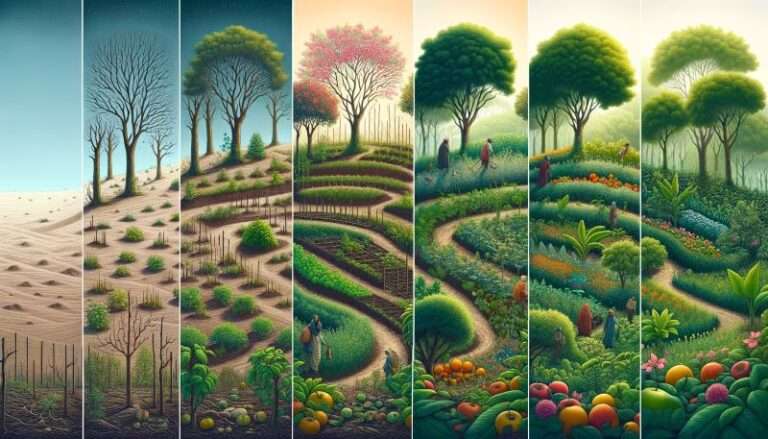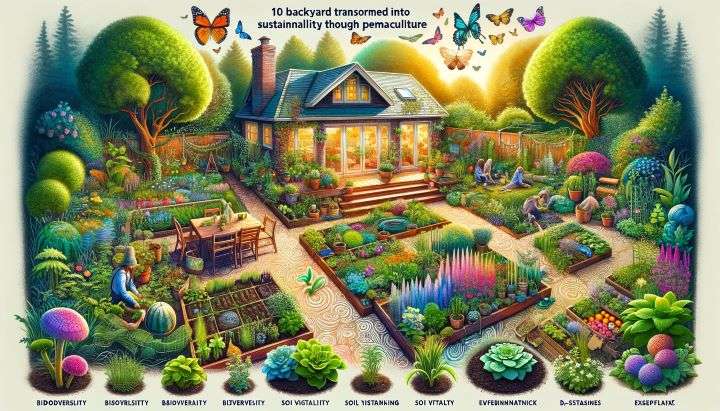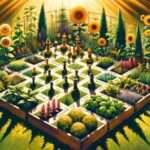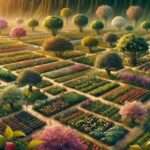This post contains affiliate links, through which we may earn a commission at no additional cost to you.
Table of Contents
Introduction
Welcome to the beautiful realms of permaculture. A place where, you know, harmony between human settlements and the natural world isn’t a mere fantasy. It’s an attainable, practical reality! Permaculture isn’t just about gardening techniques. It’s all about living philosophy that seamlessly integrates with nature’s detailed patterns and reveals cycles. This manual will take a deep dive into the centerpiece of permaculture principles. And explore how they can be wielded to build living environments that flourish in agreement with Mother Earth.
The Ethical Groundwork of Permaculture
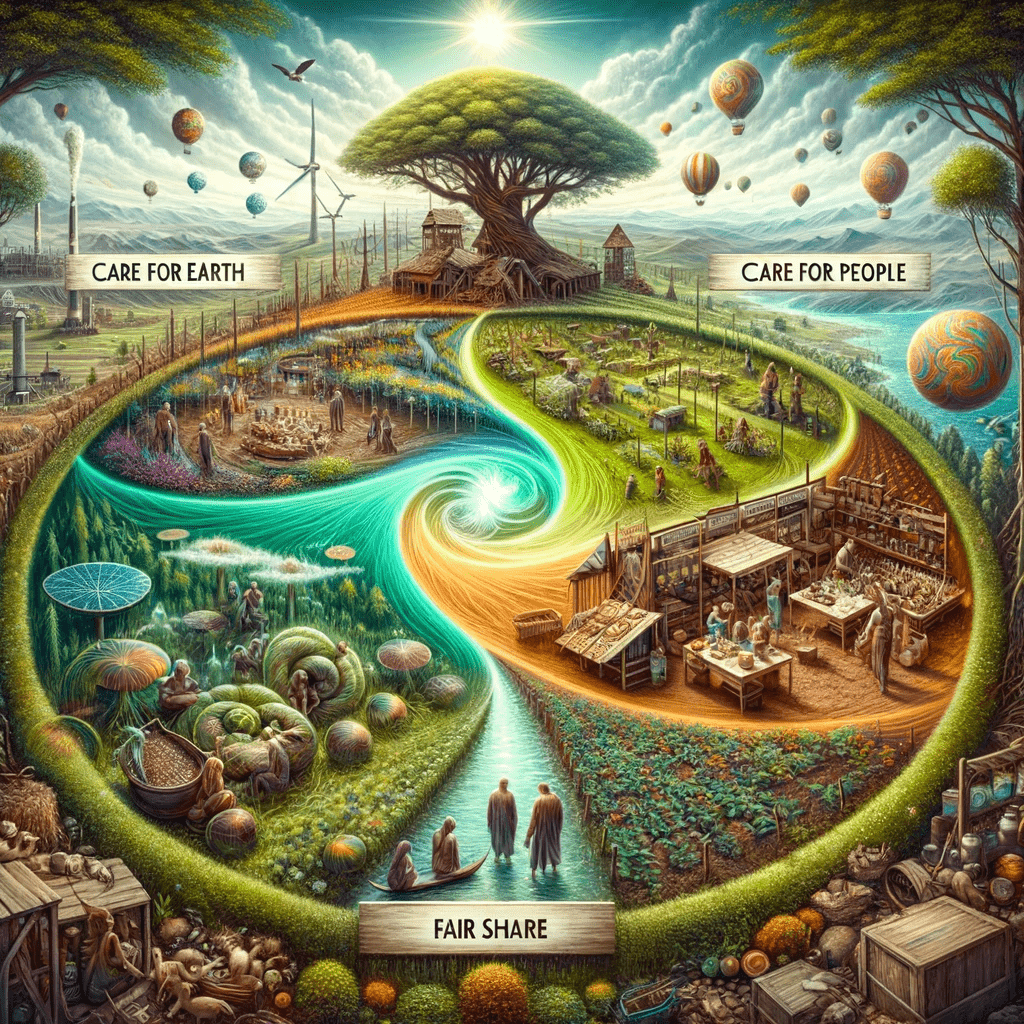
The essence of permaculture, as articulated by David Holmgren bases itself on an ethical framework. This guides our dealings with the earth and each other. These ethics-“Care for Earth,” “Care for People,” and “Fair Share”-stand as the backbone for all permaculture practices. This kind of ensures that our efforts are put in the right direction. Helping to create an earth where resources are sensibly used, and all life thrives!
Revealing the Twelve Principles of Permaculture
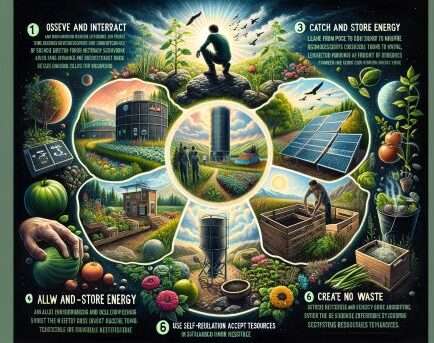
The wonder of permaculture is in its twelve fundamental principles as elucidated by David Holmgren in his book “Permaculture: Principles and Pathways beyond Sustainability.” Each is a steppingstone towards making self-reliant ecosystems. Let us share these principles and see how they light up the way to sustainable living:
Observe and Interact
Encourages individuals to engage thoughtfully with their environment, learning from it and making informed decisions that align with natural processes. Here are some examples of how you could slap this principle in real-life scenarios:
- Site Analysis Before Planting:
- Take a bit of your time to eyeball the land across different seasons, getting the gist of where sunlight kisses the ground at changing times of day, where water decides to hang out or scram, and how the winds are playing tag in that area. Grasping this can steer where to stick different veggies and plop down things like greenhouses or tool sheds.
- Wildlife Monitoring:
- Crack out a spot to peep and jot down what the wildlings are up to. Seeing which creatures drop by and what they’re up to can give you hints on what to plant (like, to pull in the good bugs for pollination, maybe) or what kind of bug-off tactics might hit the spot.
- Using Local Materials:
- By peeping at what stuff’s lying around plenty of locals, you can vibe with the ecosystem on the sustainable tip. Let’s say opting for local rocks for building, homegrown plants for making the place pretty, or turning deadwood into furniture or stuff cuts down on the need to haul stuff over distances and lightens the load on Mother Nature.
- Engaging with the Community:
- Mixing it up with the folks nearby who dig farming or gardening can inform you about what crops are a thumbs-up in the area’s weather and dirt scene, what pests are gatecrashing, and how to keep things chill naturally. Swapping brainwaves pumps up your game in the observe-interact playbook.
- Getting Wise with Water:
- Keeping your peepers peeled on how the wet stuff moves and rains down through the seasons can shape plans for catch-the-rain setups, like ditches or rain-loving gardens, that get savvy with stormwater, put a lid on washing away soil, and help the underground water stash get a refill.
- Thinking It Over and Tweaking:
- It’s essential to always look for how your green moves pan out and chop it up with your patch of green to tweak things. Based on what you see and how it’s playing out, you might need to rejig where you’ve planted stuff, fiddle with the waterworks, or mix in some new green buddies.
- Sun Mapping for Energy Efficiency:
- Catching on to the sun’s game of tag across your spot can help you boss up buildings and windows to soak in the heat come winter without breaking a sweat in the summer, trimming down on the need for artificial warm-up or cool-down.
These examples show how the principle of “Observe and Interact” can be deeply integrated into permaculture practices, enhancing both the sustainability and the productivity of the environment.
Catch and Store Energy
Emphasizes the importance of gathering and preserving various forms of energy when they are abundant, for use in times of need. This principle can be applied in many practical ways, especially in designing sustainable living and farming systems. Here are several examples:
- Rainwater Harvesting:
- So, gather all those sky tears from rooftop thingies and hoard them in big old tanks or puddles for when the earth decides to go on a dry spell. This isn’t just about getting that drip for plant watering and house needs; it’s also super chill for bossing around storm waters and telling soil to stop running off.
- Solar Energy Capture:
- Putting those shiny metallic plates up to snatch some sun giggles and flipping them over into sparky juice, which peeps can use right off the bat or stick into energy snack packs for later munching, makes those old-school chewy energy bits less of a deal and cuts down on bill shock.
- Thermal Mass:
- Chuck bricks and stuff into your crib so they can soak up all that sun love during the clock rounds and throw it back when the moon’s out. This trick comforts your pad without begging for extra warm or breezy tech. The go-to are cement, clay lumps, and rock rolls.
- Biomass:
- You are sprouting leafy dudes for burning in warm glow boxes or making zippy juice out of corn and sugar sticks for those hungry machines. You get to keep this vibe juice and use it to make your space toasty or your wheels spin whenever.
- Wind Turbines:
- Putting up those giant spiny arms to catch breeze giggles and turn them into zap zaps is the same as the sunny bit. You can use them immediately or save them for a non-sunny or less breezy day.
- Food Preservation:
- They grab all the eats when they’re popping off the charts and keep them locked down with old-timey tricks like jarring, zapping water out, or getting them drunk (fermenting). This lets you stash the chew energy for when the fields are sleeping.
- Earth Batteries:
- Digging chill spots underground, think root veggie hideouts for keeping your munchies crisp without that fancy cold box. Mother Nature’s cozy blanket keeps the goodies fresh.
- Pond and Water Tanks:
- Crafting puddle palaces or big old water stash spots to catch all that runaway aqua, not just for making the plants do the happy dance but also for whipping up fantastic little weather bubbles and critter cribs. Plus, having your water world can make your spot feel like it’s got its weather channel.
By applying the “Catch and Store Energy” principle, permaculture designs aim to create systems that are less dependent on external resources and more resilient to changes and disruptions in the environment. This approach contributes significantly to sustainability and self-sufficiency.
Produce a Yield
Emphasizes the importance of designing systems that are productive and provide tangible results that sustain and benefit those who maintain them. Here are several examples illustrating how this principle can be practically applied in various contexts:
- Edible Landscaping:
- Integration of food-producing plants into the garden designs. This could mean planting fruit trees, berry bushes, and perennial vegetables alongside ornamental plants. This approach beautifies the space and produces food for consumption, yielding multiple benefits from the same space.
- Multi-functional Spaces:
- Design areas that serve more than one purpose. For example, a rooftop or balcony can be used for both recreation and growing food. A living area with big windows can double as a greenhouse for indoor plants, providing both aesthetic value and edible produce.
- Aquaponics and hydroponics Systems:
- Set up systems that combine fish farming (aquaculture) with soilless plant cultivation (hydroponics). The fish waste furnishes nutrients for the plants, which in turn purify the waters for the fish. This symbiotic system can be highly productive in small spaces, yielding fish and plant produce.
- Animal Husbandry:
- Integrating livestock such as chickens, goats, or bees into the landscapes. Chickens can provide eggs and meat, goats can offer milk and cheese, and bees produce honey while pollinating plants. Each of these animals also contributes to the system by providing manure for compost, which enriches the soil.
- Forest Gardening:
- Establishes a layered garden that mimics natural forest structures, including tall trees, smaller trees, shrubs, herbaceous plants, ground cover, and root crops. Each layer is chosen for its yield potential, whether for food, fiber, medicine, or other products.
- Renewable Energy Production:
- They are installing systems such as solar panels, wind turbines, or biogas digesters. These technologies produce energy yields that can be used on-site, reducing energy costs and increasing self-sufficiency.
- Succession Planting:
- Planning the planting calendar to ensure continuous production. By staggering planting dates and choosing varieties with different maturation times, a garden can produce vegetables, fruits, and herbs throughout the growing season, maximizing the yield from the garden space.
- Community Supported Agriculture (CSA):
- Participating in or starting a CSA program where community members buy shares of a farm’s harvest in advance. This system ensures a guaranteed market for the farmer’s produce, provides fresh food to the community, and fosters a direct connection between producers and consumers.
These examples highlight how the principle of “Produce a Yield” can be creatively applied to ensure that any permaculture design not only supports itself but also provides abundant returns, making it sustainable and economically viable.
Allow Self-Regulation and Accept Feedback
Emphasizes the importance of observing and adapting systems based on the feedback they provide. This principle helps in creating sustainable and resilient systems by making necessary adjustments that align with natural processes and cycles. Here are several examples of how this principle can be applied in permaculture designs:
- Pest and Disease Monitoring:
- Regular observation of plants and animals for signs of disease or pest problems. Early detection allows for natural interventions, such as introducing predator insects, rather than relying on chemical pesticides. This feedback loop helps maintain the balance and health of the ecosystem.
- Soil Health Checks:
- Conducting regular soil tests to assess nutrient levels and soil structure. Feedback from these tests can guide the application of natural fertilizers, compost, or the incorporation of specific plants (like nitrogen-fixing legumes) to enhance soil fertility and structure without chemical inputs.
- Water Usage and Efficiency:
- Monitoring water usage and the efficiency of irrigation systems. Adjustments might include installing drip irrigation to reduce water waste or redesigning the landscape to better capture and store rainwater. Feedback on water levels can also lead to the creation of swales or rain gardens to manage runoff and increase infiltration.
- Success and Failure of Crops:
- Keeping records of which plant species thrive and which do not under specific conditions. This feedback is crucial for future planting decisions and helps in selecting the most appropriate crops for the local climate and soil conditions.
- Energy Consumption Analysis:
- Tracking energy usage and sources in a home or community. Feedback from this tracking can lead to adjustments such as increasing insulation, changing light fixtures to more efficient models, or adjusting the orientation of buildings and windows to maximize passive solar gain.
- Animal Behavior Observations:
- Watching how animals interconnect with their environment and with each other can provide insights into the adequacy of their habitat, the balance of species, and the health of the ecosystem. Adjustments might include altering their feed, modifying shelters, or changing the stocking density to better meet their needs.
- Feedback from Community and Market:
- In community gardening or farming, feedback from community members or customers about the types of produce they prefer, the quality, and the quantity can guide what is grown in subsequent seasons. This ensures that the garden or farm continues to meet the needs of its community while being economically viable.
- Compost Temperature Monitoring:
- Regularly checking the temperature of compost piles provides feedback on microbial activity and the decomposition process. Adjustments may be needed in the balance of carbon to nitrogen, moisture levels, or aeration to optimize compost production.
These examples illustrate how permaculture systems can be dynamically managed by allowing them to self-regulate, responding appropriately to feedback, and making adjustments to enhance sustainability and productivity.
Use and Value Renewable Resources
Emphasizes the importance of choosing resources that are naturally replenished, thereby reducing environmental impact and promoting sustainability. Here are several examples illustrating how this principle can be effectively applied:
- Solar Energies:
- Putting up solar panels for catching solar energies for electric cities and solar water heaters for hot water needs. Solar power is everywhere, not dirty, and makes less need for fossil fuels.
- Wind Energies:
- Wind turbines can generate electricity in places with enough wind resources. Just like solar, wind is a clean and renewable energy source that can provide significant power outputs depending on local situations.
- Biomass Energies:
- Utilizing organic materials such as wood chips, crop leftovers, and animal waste to make energy, heat, or biofuels. Biomass is a renewable resource when it’s managed in sustainable ways, like replanting or ensuring enough waste generation without emptiness.
- Rainwater Harvesting:
- Collect and store rainwater from roofs and other surfaces for use in watering plants, washing, and even drinking (with the right treatments). This action saves drinkable water and makes less the load on city water systems.
- Geothermal Heating and Cooling:
- Installing geothermal heat pumps that use the ground’s stable underground temperature to warm and cool places is a good idea. This technique takes advantage of renewable resources (the earth’s ground’s thermal energy) and can significantly cut heating and cooling costs.
- Natural Building Materials:
- Materials like straw bale, bamboo, clay, and cobs are used for building stuff. These materials are growing again resources and have lesser embodied energies compared to normal building materials, making them friendlier to the environment.
- Perennial Crops:
- Plant perennials, vegetables, fruits, and nuts, which do not need replanting as often as yearly and can give food year after year. This approach uses the natural regrowing of certain plant species to make food more sustainable.
- Living Fences:
- These use plants like hedges or bamboo to make borders and barriers instead of non-renewable materials like plastics or metals. These living fences can also house wildlife, soak up carbon dioxide, and improve a place’s appearance.
- Reuse of Greywater:
- Design systems to reuse greywater from baths, sinks, and washing machines for garden watering. This practice lowers the need for fresh water and uses the regrowing of water via natural and man-made purification processes.
- Human Labor and Animal Powers:
- Give value and use human labor and animal powers for tasks like plowing, moving stuff, and operating machinery. These sources of energy are renewable and can reduce dependency on fossil fuels.
Create No Waste
Emphasizes using resources wisely, recycling, and repurposing what others might consider waste, in order to minimize environmental impact and create a closed-loop system where all outputs are valued as inputs for other processes. Here are practical examples demonstrating how this principle can be effectively applied:
- Composting of Organic Matter:
- It’s all about turning kitchen leftovers, yard scraps, and other organic materials into compost to make the soil richer. This method transforms what could have been garbage into something that is very helpful, boosting the soil’s healthiness and ability to fertilize.
- Worm Farming (Vermicomposting):
- It involves using worms to break down organic waste. These worms end up making both a sort of liquid that can fertilize and worm castings, which is like super good compost. This method is mega-efficient and fits well if you’ve only got a little space.
- Water Reuse Systems:
- Install greywater systems that reuse water from sinks, showers, and laundry machines to water the garden again. This not only cuts down on water use but also takes advantage of water nutrients for plant growth before the soil cleanses it.
- Upcycling Materials:
- It’s about taking old stuff, like tires, plastic bottles, or pallets, and making it into new things, maybe planters, tiny greenhouses, or even furniture or stuff for the garden. It’s all about giving materials a second life and reducing the need for new stuff.
- Using By-Products:
- You use leftovers from one thing as the starting point for something else. For instance, straw left after making grain could cover the ground or even be used as material for building, or maybe use what’s left after brewing beer as food for animals.
- Integrated Animal Systems:
- You plan systems where animals help out the garden, with chickens fluffing up compost, goats eating up brush, or pigs churning the ground. This way, you’re leveraging what animals naturally do to help other parts of the setup.
- No-Dig Gardening:
- It’s about sticking to no-dig or no-till planting methods that help the soil stay healthy, stop erosion, and keep organic matter from disappearing. This strategy is about keeping the dirt happy, reducing work, and saving resources.
- Edible Landscaping:
- This is planning out your green space, so it generates food, massively dropping the waste of looking after lawns, like water, fertilizing products, and energy for keeping it nice. It’s aimed at getting the most out of the land regarding what you can eat.
- Resource Sharing:
- It’s about getting in on or starting up community schemes to share tools or things, so not everyone has to own stuff they hardly use. This cuts back on the wastage from making, keeping, and looking after these things.
- Natural Pest Management:
- Embracing natural ways to control pests, like planting certain plants together, bringing in predators, or using biological weaponry against pests. These tactics lower the waste from chemical pest killers and nurture a healthier living space.
These instances are a window into how permaculture is all over trying to set up systems that don’t just aim for sustainability but are also all about actively cutting down waste, basically turning what could have been thrown away into precious resources for the ecosystem.
Design from Patterns to Details
Encourages starting with a broad overview of natural and human-created patterns before focusing on specific elements. This approach helps ensure that designs are rooted in the broader ecological and cultural context, leading to more effective and sustainable solutions. Here are practical examples of how this principle can be applied in various contexts:
- Observing Natural Ecosystems:
- Before one goes ahead and sketches out a garden or agricultural system, it might be a good idea to eyeball natural ecosystems and how they do their thing. For example, getting a handle on how a forest deals with water and food bits can point the direction for making a forest garden that copies these patterns for staying tough and making more stuff grow.
- Water Flow Patterns:
- In designing landscapes, peeking at how water cruises around a site can spill the beans on where to plop stuff like swales, ponds, or rain catchers. By reading the book about nature’s water-moving ways, someone can juggle water bits and bobs without watering too much.
- Wind Patterns:
- Getting the skinny on which way the wind blows and how much it huffs and puffs can be a clutch for figuring out where to stick wind blocks, big houses, and even beds of flowers and veggies. This ensures the natural breeze is bagged up just right, whether for chilling places down, keeping plants from getting knocked over, or making air flow like nobody’s business without powering it up.
- Sun Path:
- Catching on to the sun’s road trip across land helps draw up buildings and put gardens down so that you soak up the sun for warmness and bright stuff while not getting too baked and giving plants enough light to do their food-making bit.
- Zoning:
- Perma-something zoning is thinking up a plan for a spot that sorts of stuff based on how much they need people poking around. Watching how folks move and what they do daily can give tips on where to park things that require a lot of TLCS or are used a lot, like herb patches (by the cooking spot) or chicken hangouts (near the trash).
- Soil and Terrain Patterns:
- Sketching out what kind of dirt and lumpy or flat bits are around helps in pegging the best spots for different green guys, like sticking tough water-hating plants on high spots with skinny dirt or water-happy plants in soggier, low-down spots.
- Cultural and Economic Patterns:
- When designing city stuff, paying mind to the ways of people and the flow of money can shape plans that fit what folks need, what’s there to use, and ways to keep the cash rolling correctly. This could mean setting up places for the community to grow veggies without much food shopping or making spots that let local shops do their thing.
- Traffic and Access Patterns:
- Watching how people and cars dance through a spot can give ideas for laying out walkways, streets, and doorways that aren’t a pain and don’t get too jammed, making it easier to get around and safer.
- Animal Behavior Patterns:
- Getting what animals and critters are up to can help in whipping up setups that work with their lives and movements, like placing homes for birds where they’re likely to scout for cozy spots or putting barriers so that critters can still do their thing.
- Climate Patterns:
- Getting the lowdown on local weather moods, like when it changes, how rain does its thing, and how hot or cold it gets, can tip off what kind of green buddies to hang out with, when to get them in the ground, and how to build hideouts from the weather.
By designing from patterns to details, permaculture practitioners can create systems that are deeply integrated with their environment, enhancing sustainability and reducing the need for external inputs. This principle ensures that the design works with nature rather than against it, leading to more resilient and adaptive systems.
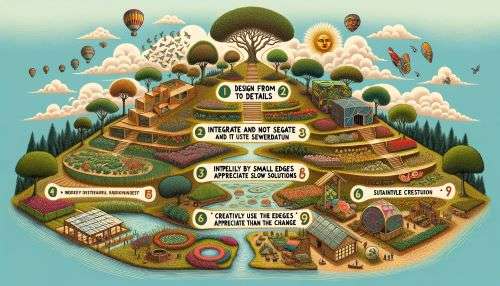
Integrate and Not Segregate
Emphasizes the importance of creating systems where components work together synergistically, enhancing overall system health and productivity. Here are some practical examples of how this principle of permaculture can be applied:
- Companion Planting:
- Cultivating various plants that support each other, for instance, the trio known as “Three Sisters” – which includes corn, beans, and squash – is beneficial. The corn assists as a natural trellis for the beans to ascend, the beans enrich the soil with nitrogen for the growth of all three, and the squash spreads out over the soil, providing shade that helps in weed control and moisture retention.
- Food Forests:
- Mimicking the layers of a natural forest, a food forest integrates trees, shrubs, perennials, and ground covers to support biodiversity and maximize yield. Different plants perform multiple functions, such as providing habitat for beneficial insects, improving soil health, and producing food.
- Animal Integration in Crop Systems:
- Using livestock to provide multiple functions within agricultural systems. Chickens can be rotated through orchards or crop areas to eat pests and weeds while fertilizing the soil. Pigs can be used to clear and turn over land in preparation for new plantings.
- Aquaponics:
- Merging aquaculture with hydroponic systems for vegetable cultivation creates a sustainable cycle. Here, fish waste acts as a natural nutrient source for the plants. Concurrently, the vegetation purifies the water, which is then recirculated back to the fish. This process forms a self-sustaining loop.
- Habitat Features for Wildlife:
- Integrating habitat features such as ponds, hedges, and nesting boxes into agricultural or garden settings to encourage beneficial wildlife, which can aid in pest control and pollination, contributing to biodiversity and ecosystem health.
- Stacking Functions:
- Designing garden elements to serve multiple functions. For example, a pergola can provide support for climbing plants, shade for humans, and habitat for birds simultaneously. Another example is a rainwater collection system that serves as a greenhouse structure.
- Shared Community Resources:
- Designing community spaces that serve multiple user groups and functions, like community gardens that provide space for social gatherings, education, and local food production, strengthening community ties and resilience.
- Multi-Use Pathways:
- Pathways in a garden that allow for movement and access while also serving as water infiltration zones and sites for growing edge species such as herbs and flowers.
- Thermal Mass for Energy Efficiency:
- Incorporating materials that possess a significant ability to store heat, such as concrete or stone, within structures absorbs warmth throughout the daylight hours and discharges it during the nighttime. This practice diminishes the requirement for external heating and cooling energy.
- Integrated Waste Management:
- They are implementing systems where waste products from one process become resources for another. For example, using greywater from the household for garden irrigation or turning wood chips and sawdust into mulch or mushroom cultivation mediums.
These examples demonstrate how integration rather than segregation in permaculture design optimizes resource use and encourages diversity, resilience, and sustainability in ecosystems and human communities alike.
Implement Small and Slow Solutions
Encourages starting with small-scale, manageable projects focusing on long-term sustainability and gradual improvements. This approach allows for careful observation and adaptation based on feedback from the system, minimizing risk and resource waste. Here are several practical examples of how this permaculture principle can be applied:
- Start with a Small Garden Plot:
- Instead of converting a large area into a garden, begin with a small plot to learn about the soil, local conditions, and what grows best. This manageable size allows for easier adjustments and experimentation with less risk of failure.
- Gradual Water System Development:
- Instead of installing an extensive, complex water catchment system all at once, start with a single rain barrel to harvest water from a downspout. As you learn more about your water needs and collection potential, gradually expand with more barrels or add other elements like a small pond or swale.
- Incremental Composting:
- Begin composting with a simple one-bin system. As you become more familiar with the process and your garden’s waste output and compost needs increase, you can expand to more complex systems or try different methods like worm composting or bokashi.
- Phased Planting in Permaculture Zones:
- Implement zoning by slowly developing one zone at a time, starting with the areas closest to the home or most frequently used. This approach allows each zone to be established and observed before moving on to the next, ensuring each area is well adapted to its specific function and interactions.
- Small Livestock Introduction:
- Begin with a few chickens or rabbits before introducing larger livestock like goats or cows. This slower approach helps you learn animal care on a manageable scale and understand how the animals integrate into your permaculture system.
- Slowly Expanding Perennial Areas:
- Start by planting key perennial crops and observing their growth and productivity. Over time, gradually increase the diversity and area of perennials based on successful species and your observations of their interactions with the environment.
- Miniature Greenhouses:
- Build a small greenhouse or cold frame to continue the growing season for a few plants. This project can provide insights into microclimate management and can be expanded as needed based on success rates and learning outcomes.
- Use of Modular Elements:
- Employ modular garden beds, containers, or trellises that can be easily moved or rearranged as you refine your garden layout and plant choices. This flexibility allows for slow and deliberate changes to the system without significant upheavals.
- Energy Efficiency Upgrades:
- Start with small, simple changes to increase home energy efficiency, such as replacing light bulbs with LED versions or installing low-flow showerheads, before committing to larger projects like solar panel installation or major insulation upgrades.
- Community Engagement Initiatives:
- Initiate small community projects like a shared tool library or a monthly seed swap before attempting larger endeavors such as establishing a community garden or cooperative. These smaller initiatives build community ties and gauge interest, which can inform and support more significant projects.
These examples illustrate how starting small and growing slowly allows permaculture systems to develop sustainably, with adjustments made based on practical experiences and specific conditions. This thoughtful, phased approach can lead to more robust and resilient systems.
Use and Value Diversity
Stresses the importance of incorporating a variety of elements within a system to enhance its resilience and productivity. By using and valuing diversity, systems can better adapt to changing conditions and resist pest and disease pressures. Here are practical examples showing how principle of permaculture can be implemented:
- Diverse Plant Species in Gardens:
- Hey! You’re bulletproofing your garden if you throw a jumble of veggies, fruits, herbs, and flowers together. This crazy mix can repel pests and gross diseases that try to blitz your whole salad bar, and it can perk up dirt health with all those different roots doing their thing and munching on nutrients.
- Polyculture Farming:
- Instead of boring old monoculture, polyculture is the way to go. It gets all cozy with multiple crop species hanging out in the same pad. This shindig is like copying Mother Nature’s backyard, slashing the need for nasty chemical stuff and making your garden a chill spot for more cool bugs and dirt buddies.
- Agroforestry Systems:
- Mashing trees, shrubs, and crops together in agroforestry systems can jazz up biodiversity and make the ground all fancy. Trees are fantastic because they’re like big umbrellas for critters, keep the dirt from running away, and sometimes give you free snacks like fruit, nuts, or even stuff you can build with.
- Animal Species Diversity:
- A mixtape of livestock breeds can pump up the genetic party and toughness. Different squad members come with their snack preferences, superhero shields against sickness, and vibes for various weather, making your farm team super flexible and sturdy.
- Genetic Diversity in Crops:
- Rocking heirloom and neighborhood-famous seeds can boost the gene pool party within crops, making them tough as nails against bugs, icky diseases, and even moody weather. It’s like keeping your grandpa’s farming mixtape alive and kicking.
- Ecological Habitats:
- Building remarkable cribs like ponds, meadows, and forests in your green kingdom encourages all the wildlife BFFs to visit, which is wicked for keeping pests in check and getting free pollination services. Each groovy crib is a VIP lounge for different wild pals, hooking up the whole ecosystem.
- Functional Diversity in Design:
- Squeezing extra juice out of your garden by making things do many jobs is wicked smart. A hedge isn’t just a pretty face; it can block wind, keep nosy neighbors out, be a highway for animals, and even grow munchies if you pick the right plants.
- Diverse Water Sources:
- Tapping into a bunch of water tunes, like catching rain, reusing greywater, and dripping water right to your thirsty plants, ensures you’ve always got a drink to hand out, regardless of the sky’s mood. This way, you’re not just waiting for the tap to work.
- Social and Cultural Diversity:
- Getting folks from all over with different stories and brainwaves can produce some genius ideas for tackling local head-scratchers. This mix of peeps can whip up super cool and intelligent moves in your green projects.
- Economic Diversity:
- Having lots of money-making schemes from your green digs, like selling fresh veggies, teaching peeps how to garden, inviting tourists to ooh and aah at your place, or selling swag, keeps your wallet happy and dances around any cash droughts.
These examples highlight how diversity can be leveraged to create more productive, sustainable, and resilient systems in permaculture design, ultimately leading to healthier environments and communities.
Employ Edges and Appreciate the Marginal
Highlights the value in utilizing a space’s edges and marginal areas, as these are often the most diverse and productive parts of any system. This principle can be applied in many ways to enhance productivity and biodiversity. Here are some practical examples:
- Edge Planting in Gardens:
- Plant along the borders of garden beds or at the interface between different ecosystems, such as where a forest meets a field. Due to the overlapping conditions and resources, these edge spaces can support a greater diversity of plants, often leading to increased productivity and beneficial interactions among species.
- Riparian Buffers:
- Establishing vegetation along the edges of streams and rivers to act as riparian buffers. These areas can help filter pollutants, provide habitat for wildlife, stabilize riverbanks, and enhance biodiversity. They are critical in maintaining ecosystem health and water quality.
- Hedgerows and Windbreaks:
- Utilizing hedgerows or windbreaks at the edges of property lines or between agricultural plots provides shelter from wind and erosion and habitat for beneficial insects, birds, and other wildlife, contributing to pest control and pollination.
- Pond Edges:
- Designing ponds with irregular, naturalistic edges rather than uniform, straight lines. The increased edge length can support more aquatic and semi-aquatic plants and animals, maximizing the ecological productivity of the water body.
- Terrace Gardens:
- Creating terraces in hilly or sloped areas can turn marginal sloping land into productive garden space. By slowing and capturing water runoff, terraces can reduce soil erosion and make more efficient use of rainfall.
- Forest Edges:
- Managing forest edges increases light penetration and promotes the growth of diverse plant species. Forest edges can be highly productive for foraging wild foods and medicinal herbs.
- Green Roofs and Walls:
- Utilizing the marginal spaces of building roofs and walls for growing plants. Green roofs and walls can help create insulation, lessen urban heat island effects, and provide additional growing spaces in urban environments.
- Marginal Land for Bioenergy Crops:
- Using less fertile, marginal lands to grow bioenergy crops (like willow or miscanthus) that do not compete with food crops. These plants can thrive on marginal lands and provide biomass for energy production.
- Permaculture Swales:
- Constructing swales along the contour lines of a landscape. These swales catch and hold runoff water, increasing its infiltration into the ground. This technique turns marginal sloped lands into productive areas by enhancing soil moisture.
- Wildlife Corridors:
- Creating strips of habitat that connect larger ecosystems, enabling wildlife to move safely across human-dominated landscapes. These corridors often utilize marginal strips of land but can significantly contribute to biodiversity conservation.
By focusing on edges and marginal areas, permaculture designs can optimize the use of available space, enhance ecological diversity, and create more resilient systems. This approach ensures that every part of the land is valued and utilized effectively, no matter how seemingly insignificant.
Creatively Use and React to Change
Emphasizes the importance of being flexible and adaptive in designing systems that can evolve over time as conditions change. This principle encourages viewing change as an inevitable and potentially positive force that can be harnessed creatively. Here are several examples of how this principle can be applied:
- Climate Change Adaptation:
- Adjusting the scheduling of when plants get planted, alongside picking types of crops that are more suited to the up-and-coming weather changes, like more considerable warmth or not the same rainfall patterns. This might include moving to crops that don’t need much water or can take more heat as the weather turns dry or hot.
- Successional Plantation:
- Designing green areas and farm setups to be better over time by choosing plants that grow at not the same speeds or enjoy the new conditions made by the old crops. For example, quicky-grow annuals can be planted before long-root perennials, which can really use the dirt’s upgraded states thanks to the annuals.
- Economic Shifts:
- Reacting to how money moves by finding more ways to earn income from a permaculture spot. Maybe starting tours that teach, workshops, or creating added-value goods, such as jammies or plant-based cure-alls, when traditional farm selling goes down or what people want starts to shift.
- Technology Integration:
- Putting in new technologies for better sustainability or efficiencies, like solar things that keep an eye on water use really precisely, changing how much water gets used depending on the dryness of the ground and weather, tells us what’s coming.
- Urban Growth and Development:
- Making permaculture fit into cities as they get more big, like making gardens on roofs, farming up walls, or making community green spots in small or weird-shaped lands.
- Pest and Disease Outbreaks:
- Changing how gardening or farming gets done because of new bugs or plant sicknesses. This might be bringing in bug-eating friends, choosing different crops that don’t get sick as quickly, or using more brutal ways to keep pests away without hurting everything.
- Water Management Innovations:
- Getting clever with water use because there are different amounts of rain involves building more extensive systems for catching rainwater or drip water, which saves a lot of water.
- Social Dynamics:
- Changing what plants are grown or how farming is done based on what the people in the place like more or need because of how things are changing in society, focusing on sharing food in community groups or doing farming everyone helps with.
- Soil Fertility Changes:
- Moving with the changes in how good the soil is by trying new ways to make compost, rotating the crops to keep dirt nutrients happy, or putting cover plants to improve the ground.
- Wildfire Recovery:
- In spots where fires happen frequently or where people are trying to recover after fires, plants that don’t burn as easily should be used, safe spots should be made to keep fires away, and the land should be made in ways that can better withstand fires and get back on its feet after being burned.
Implementing Permaculture Principles for Sustainable Living Habitats
The use of permaculture principles lead to sustainable living habitats that are self-supporting and regenerative, and putting a hand in healing our globe. Some of you might ask, how do these principles come alive?
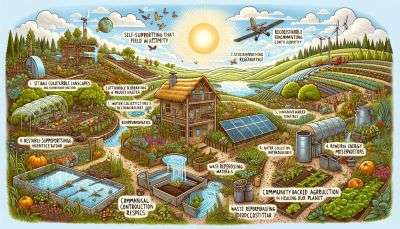
Edible Landscapes: Designing gardens and landscapes that produce food lets us create visually attractive spaces that also feed us!
Water Collection Mechanisms: Capturing and reusing rainwater reduces dependency on external water sources and lessens the effect of droughts.
Renewable Energy Resources: Applying solar, wind, and other renewable energy sources reduces carbon footprints and encourages energy independence.
Natural Construction Materials: Choosing locally sourced and sustainable materials reduces ecological impact and creates healthier living areas.
Waste Repurposing and Composting: Converting organic waste into compost concludes the loop, enriching soils without synthetic fertilizers.
Community Backed Agriculture (CSA): CSA involvement promotes community bonding and connection to food sources, supporting sustainable farming!
The Route Towards a Permaculture Future
Venturing on the path of permaculture is like a call to reinvent our standing within the environment. It’s a dedication for a future where people live in symbiosis with the environment, tendering the planet while drawing from its abundance to fulfill our needs. Permaculture principles allow us to mold sustainable living habitats that not only conserve but add richness to the elegance of Earth for generations to come.

As we travel ahead, let’s take with us the essence of permaculture: deep respect for the natural world, a dedication to sustainability, and unnecessary excessive enthusiasm. By embracing these principles and incorporating them into our lives, trees are delicious! We can help create a world where sustainability is not simply ideological thinking but tangible reality.
What is the importance of water in permaculture design?
Water is crucial in permaculture design for creating sustainable systems by maximizing rainwater retention in the landscape, reducing reliance on external water sources, and designing efficient irrigation systems to support plant life.
How does permaculture contribute to sustainability?
Permaculture contributes to sustainability by mimicking natural ecosystems to create productive environments, reduce waste, conserve resources, support biodiversity, and promote ecological balance and resilience.
What role do animals play in a permaculture system?
Animals play a vital role in a permaculture system by contributing to nutrient cycling, aiding in pest control, and providing food and other resources, thus enhancing the system’s productivity and diversity..

